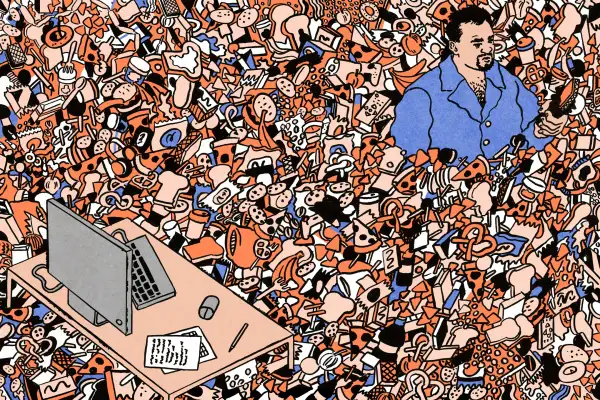Endless Snacks and the Temptation of Naps: What it's Really Like to Work From Home

Most people are jealous when I tell them I work from home.
And I’ll admit, in the seven years I’ve been a freelance writer, the words “I miss working in an office” have never once left my lips.
Of course, I’m not the only person with this privilege. A 2019 survey by Owl Labs found that 62% of U.S. employees work remotely at least occasionally. Of that group, 54% of respondents say they work remotely at least once per month, and 30% work remotely full-time.
Ditching the cubicle life was one of the best decisions I’ve ever made. Still, it’s not right for everyone. Some days it’s a pajama lover’s paradise — but the arrangement has its drawbacks, too.
Here are the ups and downs of working from home that nobody talks about.
Pro: No crappy commute
I like to joke that I “walk to work” — the punchline being that I walk up a flight of stairs to get from my bedroom to my living room, i.e., my makeshift office.
By comparison, the average one-way commute time for American workers hit a record-high 27.1 minutes in 2018, the Census Bureau reports. And let’s take a moment of silence to mourn for commuters in East Stroudsburg, PA, where schlepping to work takes an average 38.6 minutes each way, the longest commute in the U.S.
It turns out, my 10-second commute may also be good for my health: a study published in the American Journal of Preventive Medicine found that people who drive long distances (around 15 miles or more each way) are more likely to be obese and have high blood pressure compared to their non-commuting counterparts.
I’m also saving a lot of money: Gasoline where I live (the suburbs of Washington, D.C.) is expensive, and gridlock in the nation’s capital stinks. Last year, commuters who drove to work in the Washington, D.C. area spent, on average, $596.98 on fuel costs, online referral service Clever reports. Public transportation costs can add up too: most fares for Washington, D.C.’s metro rail range from $2.25 to $6 per trip during peak hours (5 a.m.-9:30 a.m. and 3 p.m.-7 p.m.).
Con: Fighting the temptation to snack
I’ll confess: I’m a snacker. I prefer the sweet stuff — Oreos, Reese’s Cups, and chocolate Nips (if you’re not familiar with this “old man candy,” you’re missing out). Unfortunately, I’ve learned that I’m more susceptible to noshing throughout the day when I work from home. Because there’s no one here to judge me, I have no shame in scarfing down a few cookies before lunch, which isn’t great for my waistline.
To make up for the extra calories, I’ve had to add about 10 minutes to my cardio routine, bringing me to about a 40-minute jog, four days a week.
Con: It requires self-discipline
Colleagues have a harder time accessing you — and disrupting your workflow — when you work at home. Still, it’s challenging to focus on work when you’re not actually at work.
Case in point: telling yourself that you’re going to watch just “a few minutes” of television can be a slippery slope. Before you realize it, you’ve binge-watched an entire season of The Marvelous Mrs. Maisel instead of working on your report that’s due tomorrow.
And there are other distractions, too. At least in my case, my mom uses the fact that I work from home as a free pass to call me during any hour of the workday. So does my grandmother. (Sorry, Bubbie!)
Pro: NAPS.
Because I’m self-employed, I set my own hours — and that means my alarm clock goes off at 10:15 a.m. every day (and, to be honest, sometimes I hit “snooze.”)
Not all remote workers have that kind of flexibility, but most have the freedom to take naps when they’re not busy — which studies show can boost productivity.
This is another area that requires some self-control. I try to limit myself to one nap a week, sleeping anywhere from 20 minutes to two hours, depending on how much work I have on my plate. But there are definitely days when I’m tempted to lie down on my couch, close the blinds, and cue up a “sleep” playlist on Spotify — even when I know I shouldn’t.
Con: It can get a little lonely
Working from home can be isolating, which may explain why about 1,000 coworking spaces, like WeWork, were opened in the U.S. in 2018, according to a 2019 report by the industry group Coworking Resources. Personally, I’m too cheap to pay for a coworking membership or a private office — which costs about $820 a month at WeWork's Midtown Center office in D.C.— and I’m too lazy to go to a coffee shop to work.
At the end of my workday, I’m usually craving a little social interaction, so I head to the gym to be around other people. Exchanging a few head nods with the familiar faces who exercise at around 4 p.m. every day always gives me a mental boost.
Pro: It’s always “casual Friday”
I gladly said goodbye to formal attire when I stopped working at an office, which meant trading in my khakis and button-down shirts for sweatpants and T-shirts.
This probably seems like a small luxury, but a growing body of research shows that dressing casually actually increases job satisfaction for many professionals.
In a 2019 survey by the international HR services provider Randstad, one-third of all workers (and 41% of those who currently work in offices with conservative dress codes) said they would rather have the option to dress down than bump their salary by $5,000. An additional 33% said they would rather quit their job or not accept a new offer than follow a strict, conservative dress code.
Another bonus of working from home? Since I don’t have to worry about things like ironing my clothes or straightening my tie, I can carve out more time during the day to do chores like laundry, grocery shopping, or cleaning up around the house. (OK, that last one is usually aspirational.)
